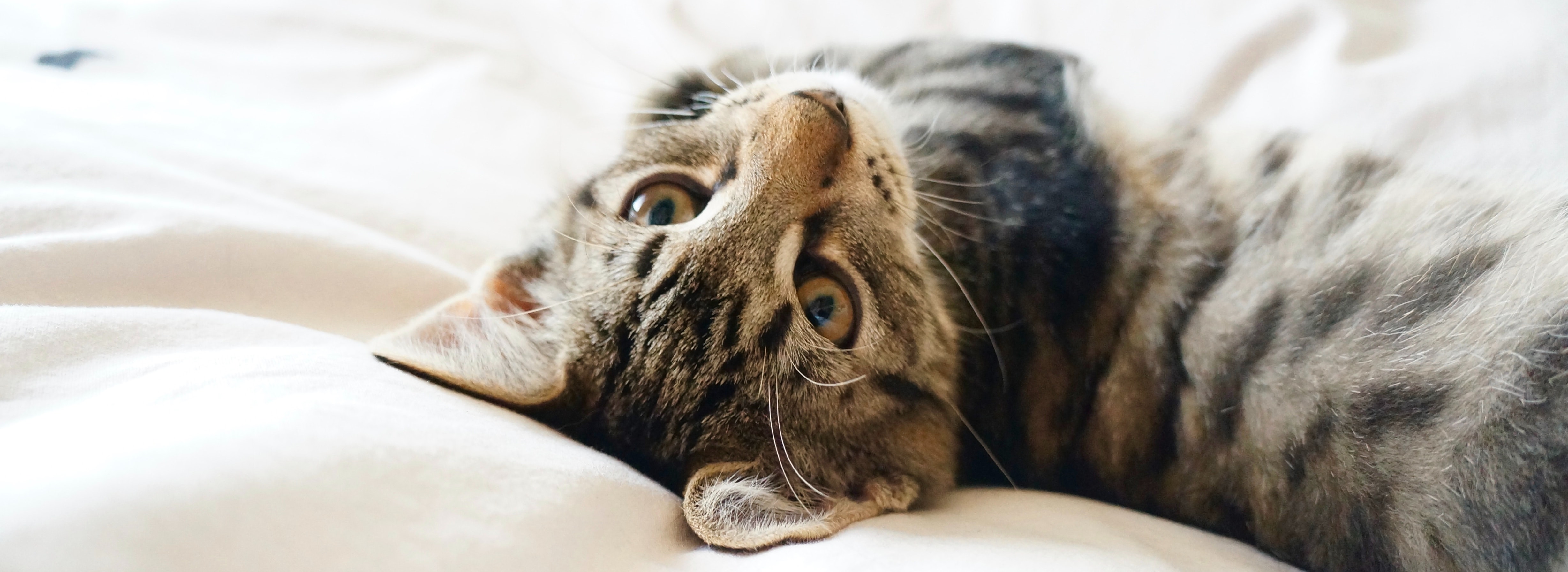
Photo by Anthony De Kroon
Kitten Behaviours and Ways of Communicating
Kittens have a few ways of communicating with other cats and their humans, from body language to various kitten sounds. And if there’s one thing cuter than a kitten, it’s a purring kitten! Not to mention a nuzzling kitten!
But as cute as they are, these sounds and signals are used to make important things known, so are worth paying attention to. Here are a few of the most common elements of kitten communication and what they mean.
Understanding your kitten’s body language
Your kitty will generally let you know how they’re feeling through body language. Look out for the following things in your kitten’s behaviour to understand them a bit better:
Tail movements
You can tell a lot about your kitten’s mood from the way they’re moving their tail. If it’s up in the air or in a question mark shape, it’s usually a good sign that they’re feeling friendly. Waving their tail from side to side can mean they’re excited or focused. And holding their tail to one side, between their legs or with their fur fluffed up can indicate they’re upset or scared.
Ear movements
A happy kitten’s ears will generally point up and be positioned slightly forward, but if you spot twitching or rotating movements, this can be a sign that your kitten is agitated. Pinning their ears back against their head can signify fear or anger.
Rolling over
Kittens usually roll onto their back to show you that they trust you and they’re feeling sociable - especially if it’s paired with lots of happy purring. Best not to take it as an invitation to touch their belly though, unless you know your kitten likes it!
Rubbing
If your kitten is rubbing up against you or your furniture, they’re likely scent marking. This helps them feel more at ease, as it makes the place (or you) smell more familiar. It can also be seen as a sign of affection, as they’re essentially marking you as ‘theirs’!
Scratching
Scratching is an instinctive kitten behaviour. They do it to express excitement or stress, or to mark their territory. They may also do it if they’re feeling bored, so make sure you spend time playing with your kitty each day. Not only will playing keep your fur baby happy and entertained, it’ll get them used to human interaction too.
Understanding your kitten’s sounds
Your kitten may not be able to speak your language, but they do have a voice! From meowing to purring, kittens have a few different ways of communicating vocally, such as these:
Purring
If you’re wondering what your kitten’s purring means, it won’t come as any big surprise to know that a purring kitten is usually a happy kitten. They’ll use purrs to communicate with their mum, and to tell you they’re enjoying something, whether that’s a loving stroke or a tasty meal.
Meowing
Did you know that adult cats only use their meow when they’re communicating with humans? It’s as though they save this language just for us! Kittens, on the other hand, also meow to their mums for attention and will use it to get their human’s attention too.
Trilling
This high-pitched trilling sound is like a cross between a meow and a purr. It’s used as a greeting, whether that’s between a kitten and their mum or with a person.
Chirrup
If you’ve heard your kitten making a kind of chirping sound like a bird, this is known as a ‘chirrup’. The common noise varies in tone and can mean different things. Your kitten might use a ‘chirrup’ to get their mum’s attention, or they’ll use it when they’ve seen something exciting they can’t get at. So, if you spot them at the window with their ears sticking up, chances are they’ve seen a possum or bird!
How to communicate with kittens
Not sure how to communicate with kittens? Don’t fret, you don’t need to learn how to meow! Communicating with your kitten is all about body language, tone of voice and patience.
Why not try the following things to start interacting with your new feline pal?
Talk to them
There’s no shame in talking to your kitten. In fact, it’s a great way to bond with your furry friend! Just make sure your tone and body language match the context. A higher-pitched, happy voice (the baby voice you naturally adopt for cute kittens) is great for showing affection and praise, whereas a firmer tone works for commands. It’s also important to be consistent when making commands by using the same words and gestures.
Try blinking
It’s thought that slowly opening and closing your eyes can make cats feel more comfortable, and help you form a better connection with them. This is a very non-threatening gesture, which encourages your kitten to trust you and open up to affection. You may even notice them doing it too as a sign of affection!
Be patient
You can’t expect your kitten to become a genius overnight, but the more you try to communicate with them, the faster they will learn. Be patient and consistent and you’ll be besties in no time.
Keeping your kitten content
When you welcome a new furry bundle of joy to the family, the most important thing is that they’re happy and at ease in their new home.
Here are a few things you can do to keep your kitten feeling content:
Set yourself up for success
Before you bring your new kitten home, make sure you get everything they need to feel at home. Create a cosy space for them with a comfy bed and blanket, litter tray, and bowls for food and water. Keep in mind that our fussy cats prefer their bowls not to be too near each other, and away from busy areas.
Stock up on kitten food
One way to bring out the happy purrs in your new feline family member is by choosing the right kitten food. To start with, it’s best to give your kitten whatever they’ve been eating at the breeders or rescue centre – this will help them to settle in and avoid upsetting their belly.
But when you’re ready to introduce new food, Whiskas© kitten food is a great choice, as it contains all the nutrition they need to grow and thrive. Introduce it to your kitten’s diet gradually by mixing in a little of the new food with their old food.
Understand their purrs
While a purring kitten is usually a happy one, cats also purr to self-soothe when they are unwell, in pain or stressed. Knowing what it means when your kitten purrs at you is all about judging the context and how they seem in more general terms. Check out our article on [what it means when cats purr] to learn more.
Hopefully now that you know a bit more about kitten behaviour and how to communicate with them, you’ll be right on track to building a wonderful bond with your new furry friend. For more tips on caring for your cat through their life, check out the other content in our Guide to Purrrfect Living.
@2023 Mars or Affiliates.








